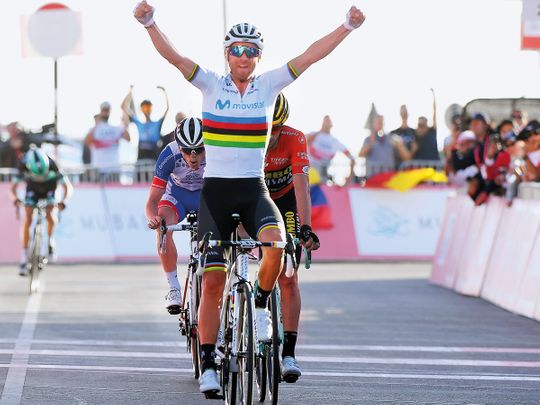
Dubai: The UCI, the world governing body for cycling, has published detailed protocol guidelines, making clear the fresh procedures that need to be followed as the world prepares for the restart of the sport from the beginning of August.
The UCI had established a revised 2020 UCI World Tour in the first week of May, which will now commence with the Strade Bianche on August 1 and conclude with the Vuelta a Espana on November 8.
The UCI series includes 25 events, of which 17 are one-day races, including the five Monuments (Milano-Sanremo, Tour des Flandres, Paris-Roubaix, Liège-Bastogne-Liege et Il Lombardia) and eight stage races, including the three Grands Tours — the Giro d’Italia, Tour de France and Vuelta a Espana.
The new document on protocol to be followed at least for the remainder of this season is based on the work of the World Health Organisation (WHO) and an international task force that was set up by World Athletics.
For cycling, the steering group was led by UCI Medical Director, Professor Xavier Bigard along with representatives of riders, teams, cycling’s doctors and organisers along with Katerina Nash in her role of President of the UCI Athletes’ Commission.
There are three general principles at the origin of the organisation protocol for competitions, namely a general one for teams and their entourage, the second one for the three levels of the pandemic and the third concerning measures considered mandatory, recommended or desired as per the severity of the situation.
The first is that each team (riders, entourage and doctors) will be required to form a “team bubble”. When the race starts, the team bubbles will join to form a “peloton bubble” which must adhere to the measures adopted.
The second principle caters to the three levels of the pandemic, while varying according to their intensity: a “moderate” risk level which corresponds to Phase 4 of viral pandemics as defined by the WHO (with 20 to 50 Covid-19 cases declared per week per 100,000 inhabitants); a “low” risk level corresponding to WHO’s Phase 3 (corresponding to fewer than 20 cases per 100,000 inhabitants) and a “very low” risk level (WHO’s Phase 1 and 2 or post-pandemic phase characterised by an absence of cases over a period of 3 to 4 weeks).
The measures will then be rolled out according to the moment of the competition for actions before, during and after the race.
During the race, the riders will be required to follow a protocol of daily medical monitoring. Social distancing measures will be imposed between the peloton bubble and the team bubbles on the one hand, and the organising staff, media and public on the other hand.
Despite all the prevention measures, the management of a suspected COVID-19 case during the race must be planned for. In such a case, the team doctor will be required to make direct contact with the dedicated COVID Doctor of the organiser’s medical team. This doctor will then direct the patient to the nearest COVID Centre or specialised service.
“These measures remain dependent on the laws and measures in the different host countries and may need to be adapted, but this protocol is another step towards our sport’s return to life,” UCI President David Lappartient said.
“After the announcement of the calendars, we now have the framework which will enable riders to race again. We will now continue our work by adapting this protocol of actions for disciplines other than road, notably mountain bike, whose 2020 UCI World Cup will get under way in September.”








